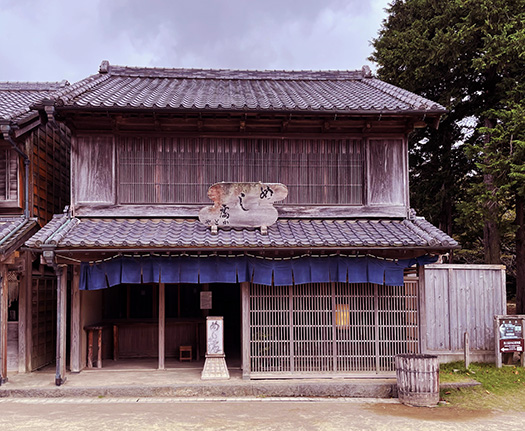
さてしばらく先史時代〜国家創成期の歴史ネタに没頭していましたが歴史から建築系にカムバック(笑)。基本スタンスの「古民家」系。仕事でも関東に広がりも出てきたこともあってその土地の「由縁」を知る意味合いからも関東各地域の住宅文化を探っていきたい。北海道でも「開拓の村」という100年前後と比較的新しい古民家の集合施設があります。過去の住宅からはそこに暮らしてきた先人の「息づかい」を体感することができる。現代住宅の祖型として学ぶべきポイントが大きいと言える。また全国で増えてきたこういう古民家文化展示について、それを体系的に整理整頓して現代的意味を構築するという動きも必要ではないかとも思っている。ということで今回は千葉県・房総の古民家探訪。「房総のむら」というすばらしい「民俗野外展示」施設があって探訪。そこでの古民家住宅体験より。
こちらには「商家」ゾーンが造作されていて江戸期の都市の庶民の生き様が活写される。
商家には、現代の基本条件とも思える「都市生活」ライフスタイルが凝縮されている。江戸の町人文化と地方らしい暮らし方の地域文化の両方の側面が房総にはあるでしょう。きょう見るのは江戸期の町人文化で芽生えた「ファストフード」文化。江戸は最盛期100万人を超える人口だったとされているけれど、そこには全国の農村からの人口移動があって、農家の次男三男層が都市に移住していった。
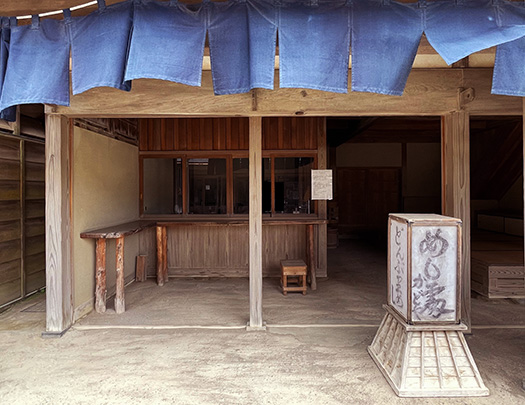
そういった人びとの食の用を満たす意味から、かけそばとか、めしやという業態が出現した。上の写真では「立ち食い」というスタイルの食事場所が提供されている。現代でこういったスタイルは都市圏生活に普遍的だけれど、やはり江戸期がその生成期だったに違いない。いわゆる「お行儀」というようなそれまでの行動規範とは違う食スタイルだったことでしょう。田舎から都市に出てきた人たちはこういう食事スタイルを見て、相当驚いたと想像できる。
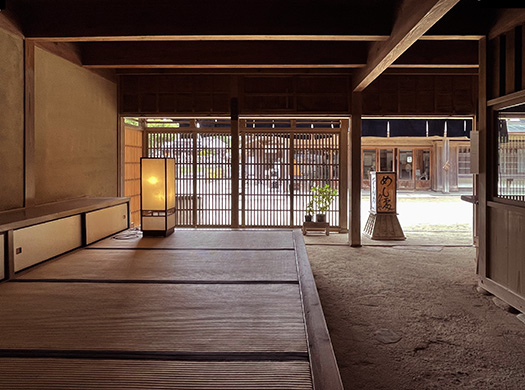
立ち食いスタイルの横には「小上がり」スペースが用意され、客層の多様性に応答した客席構成。さらにこのめしやでは2階があってより落ち着いた接客ゾーンも用意されていた。正面の木格子はガラスショーケース的に通りに対してアピールすると同時に店内からその往来の賑わいを借景させてくれる。都市生活の「活気」を感じさせる。
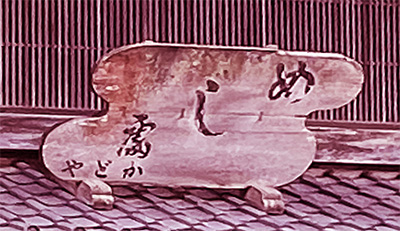
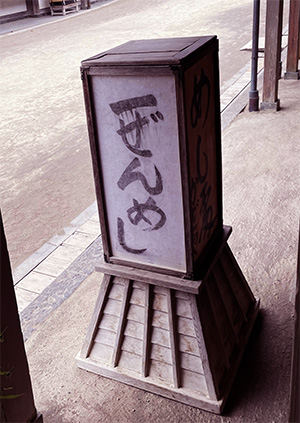
さらに日本のPOP広告・ディスプレイのスタイルの側面からも興味深い。めしや、といういかにも「食べたいなぁ」と人に印象を与えるキャッチについて、文字の表現の仕方とか、それを訴求するカタチについて店主層は工夫を凝らしたに違いない。都市という激しい競争社会のなかで日本社会での優勝劣敗のガラガラポンが日常的に繰り返されて、このような表現が優勢になっていったのだろう。日本人が好み、惹かれるデザインという淘汰が起こっていった。
English version⬇
[Fast food flourishing “Meshiya”, the bustling townhouse of Bossou in the Edo period -1
New lifestyles created by cities that welcomed surplus population from all over Japan. The first form of modern fast food is seen in the culture of merchant houses in the Edo period. …
Well, I have been immersed in historical topics from prehistory to the founding of the nation for a while, but I am now making a comeback from history to architecture (laugh). My basic stance is to focus on “old private houses. As my work has expanded to the Kanto region, I would like to explore the housing culture of each region of Kanto from the perspective of learning about the local “history” of the area. In Hokkaido, there is a relatively new collection of old private homes, called “Kaitakunomura,” which are around 100 years old. From the houses of the past, we can experience the “breath” of our ancestors who lived there. It can be said that there are significant points to be learned from them as the ancestors of modern houses. I also believe that there is a need for a movement to systematically organize and organize these old private house cultural exhibitions that are increasing in number throughout Japan, and to construct a modern meaning for them. This time, I visited an old private house in Boso, Chiba Prefecture. I visited Boso no Mura, a wonderful “folk outdoor exhibition” facility. Here is an excerpt from my experience of an old minka house there.
The “merchant house” zone was created to show the way of life of common people in the city during the Edo period.
The merchant house is a condensed version of the “urban lifestyle,” which seems to be a basic requirement for the modern age. Boso will have aspects of both the Edo period townspeople’s culture and the local culture of the provincial way of life. What we see today is the “fast food” culture that sprouted in the Edo period merchant culture. At its peak, Edo had a population of over 1 million people, and this was due to the migration of people from rural areas across the country, with the second and third sons of farmers migrating to the cities.
The kakesoba (buckwheat noodle) and meshiya (rice restaurant) businesses emerged to meet the dietary needs of these people. In the photo above, a “tachi-yoku” style eating place is being offered. This style of eating is universal in urban life today, but the Edo period must have been the period of its birth. It must have been a different style of eating from the conventional code of behavior known as “manners. One can imagine that people who came to the city from the countryside were quite surprised to see this style of eating.
A “small dining space” is provided next to the standing style, and the seating configuration responds to the diversity of the clientele. In addition, this meshiya has a second floor that provides a more relaxed customer service zone. The wooden latticework on the front of the restaurant is like a glass showcase for the street, and at the same time, it provides a view of the bustling traffic from inside the restaurant. It gives a sense of the “liveliness” of urban life.
It is also interesting from the perspective of Japanese POP advertising and display styles. The store owners must have been creative in the way they expressed the word “meshiya,” a catch phrase that gives people the impression of wanting to eat, and in the form in which they presented it. In the fiercely competitive society of urban areas, the rattle-pong of victory and defeat in Japanese society was repeated on a daily basis, and this type of expression must have prevailed. A selection of designs that the Japanese people liked and were attracted to occurred.
Posted on 1月 7th, 2023 by 三木 奎吾
Filed under: 住宅マーケティング, 日本社会・文化研究







[…] さて龍角寺についての探索、いろいろな資料を参照しながら進めてみて、やはり気になるのはほかの関東地域の豪族の遺跡と比較して中央王権としても仏教導入始原期にもかかわらず、なぜこの地に本格的仏教寺院が開設されたのか、ということ。 また、この印波国造の支配地域のなかでも龍角寺周辺の古墳群と、それに先行する古墳群とは明確にその主体者の性格にあきらかに差異が見られるという専門的所見があること。 こうした疑問は大きなナゾとして、ドンドン深まってきていた。 そういうなかでこの龍角寺のすぐ近くの「房総のむら」の「主任上席研究員」の白井久美子先生の発表文の一節に強く惹かれています。氏はとくに軍事機能を表徴する「毛彫り馬具」に注目されている。 〜6世紀以降の馬具製作には、鞍作りと仏師がともに関わったと考えられている。鞍作止利に代表される「止利派」は、推古朝における中心的な仏像製作者集団として飛鳥寺・法隆寺本尊を造像した点が知られているが、金銅薄板造りの馬装には彼らの関与が推定されている。特に、仏教色が強まった7世紀の金銅製毛彫馬具は、仏教美術の担い手によって製作された可能性の高い製品であり、新たな時代の息吹を映した馬具といえる。(中略)毛彫馬具の分布は、東日本に偏っているのが特徴(図1)で、特に、古代の東山道と東海道に集中し、群馬県(上毛野)と、静岡県(駿河)から茨城県(常陸)の分布が他を圧倒している。これらは、東北へ向かう内陸道、海道の要衝で、新式の道上型毛彫馬具は、東北 進出を図る王権の政策に応じて、活躍した東国軍団への勲章だったのかも知れない。〜 房総のむらは関東でも屈指の「民俗村」としてすばらしく、わたしも探索させていただき、ことし1月には全13回のブログシリーズでも紹介させていただいた。(連載1回目にリンクしたので辿ってみてください) そういうことなので個人的体験としても親近感があり、そちらの主任上席研究員としての探究結果には強く刮目させられる。こうした物証に踏まえての論説には非常に説得力があります。王権は京都に遷都した桓武帝以降、東北地域への進出、征夷を活発化させるけれど、関東はその武力涵養地域として意図的に勢力を育成していったという説。それも600年代中期ころから意図していたということ。そういった意図からこの地域の勢力を武力の涵養地域権力として育てていった。 後の時代の武家の棟梁・源義家は、勿来の関という福島県太平洋側から東北に進出していくのだけれど、その根拠地・出撃準備地域として下総・印波の地域で、この龍角寺を営んだ勢力が役割を果たしたというのは非常に蓋然性が高いと思います。 日本史と建築の探究、点と線が繋がってくるような楽しさであります。 […]